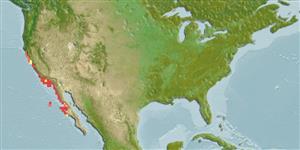>
Ovalentaria/misc (Various families in series Ovalentaria) >
Embiotocidae (Surfperches)
Etymology: Embiotoca: Greek, embios = permanent, for all the life + Greek, tokos,-oy = birth (Ref. 45335); jacksoni: jacksoni for A.C. Jackson , who first noted that black perch bore living young and brought this information to the attention of Alexander Agassiz (Ref. 4930).
Eponymy: A C Jackson, while fishing in San Salita (Sausalito) Bay, California, caught an unusual fish that had living fish inside, which he described as “…perfect miniatures of the mother”. [...] (Ref. 128868), visit book page.
More on author: Agassiz.
Environment: milieu / climate zone / depth range / distribution range
Ecología
marino demersal; rango de profundidad 0 - 46 m (Ref. 2850), usually ? - 6 m (Ref. 2850). Subtropical; 40°N - 23°N, 124°W - 114°W
Eastern Pacific: Fort Bragg in northern California, USA to central Baja California in Mexico, including Guadalupe Island (off northern central Baja California).
Tamaño / Peso / Age
Maturity: Lm ? range ? - ? cm
Max length : 39.0 cm TL macho / no sexado; (Ref. 2850); peso máximo publicado: 700.00 g (Ref. 2850); edad máxima reportada: 10 años (Ref. 56049)
Adults chiefly live in rocky areas near kelp, occasionally over sand bottom of coastal bays and around piers and pilings, and rarely in surf. Occur from intertidal areas to 46 m depth, but usually at about 6.1 m. Usually form small groups. Viviparous, female carries the developing young (Ref. 205).
Life cycle and mating behavior
Madurez | Reproducción | Puesta | Huevos | Fecundidad | Larva
Viviparous, female carries the developing young (Ref. 205).
Eschmeyer, W.N., E.S. Herald and H. Hammann, 1983. A field guide to Pacific coast fishes of North America. Boston (MA, USA): Houghton Mifflin Company. xii+336 p. (Ref. 2850)
IUCN Red List Status (Ref. 130435: Version 2024-1)
Threat to humans
Harmless
Human uses
Pesquerías: comercial; Acuario: Acuarios públicos
Herramientas
Special reports
Download XML
Fuentes de Internet
Estimates based on models
Preferred temperature (Ref.
123201): 12.8 - 19.3, mean 16.7 °C (based on 64 cells).
Phylogenetic diversity index (Ref.
82804): PD
50 = 0.7500 [Uniqueness, from 0.5 = low to 2.0 = high].
Bayesian length-weight: a=0.02951 (0.01486 - 0.05860), b=2.99 (2.81 - 3.17), in cm total length, based on LWR estimates for this species & (Sub)family-body (Ref.
93245).
Nivel trófico (Ref.
69278): 3.3 ±0.38 se; based on food items.
Resiliencia (Ref.
120179): Medio, población duplicada en un tiempo mínimo de 1.4-4.4 años (tm=1.5; tmax=10).
Fishing Vulnerability (Ref.
59153): Low to moderate vulnerability (29 of 100).
Nutrients (Ref.
124155): Calcium = 95.6 [52.9, 168.8] mg/100g; Iron = 1.15 [0.65, 1.96] mg/100g; Protein = 18.7 [17.7, 19.7] %; Omega3 = 0.264 [0.164, 0.428] g/100g; Selenium = 25.8 [13.2, 51.1] μg/100g; VitaminA = 6.99 [2.16, 22.97] μg/100g; Zinc = 0.694 [0.489, 1.013] mg/100g (wet weight);
